 3
3
 3
3
Get a Map
How to organize a collection
By David C. Harper
Do you have a jar full of old coins? Did a favorite relative give you a few silver dollars over the years? Or did you just come across something unusual that you set aside?
All three circumstances make good beginnings for collecting coins. It may surprise you, but this is how just about everybody starts in the hobby. It is a rare collector who decides to start down the hobby road without first having come into a few coins one way or another.
What these random groupings lack is organization. It is organization that makes a collection. But think about it another way: Organization is the map that tells you where you can go in coin collecting and how you can get there.
Have you ever been at a large fair or a huge office building and seen the maps that say “you are here”? Did you ever consider that, over time, thousands of other people have stood on the same spot? This is true in numismatics also. Figuratively, you are standing on the same spot on which the writers of this book stood at some point in their lives.
At a fair, the map helps you consider various ways of seeing all the sights. In coin collecting, too, there are different ways to organize a collection. The method you choose helps you see the hobby sights you want to see.
It should be something that suits you. Remember, do what you want to do. See what you want to see. But don’t be afraid to make a mistake; there aren’t any. Just as one can easily retrace steps at a fair, one can turn around and head in another direction in the coin-collecting hobby. Besides, when you start off for any given point, often you see something along the way that was unplanned but more interesting. That’s numismatics.
There are two major ways to organize a collection: by type, and by date and mintmark. These approaches work in basically the same fashion for coins of the United States, Canada and Mexico. Naturally, there are differences. But to establish the concepts, let’s focus first on U.S. coins.
United States
Let’s take collecting by type first. Look at your jar of coins, or take the change out of your pocket. You find Abraham Lincoln and the Lincoln Memorial on most cents and four commemorative reverse designs in 2009. You find Thomas Jefferson and his home, Monticello, on most nickels, but special reverse designs were produced in 2004 and 2005 and a new obverse began in 2006. Franklin D. Roosevelt and a torch share the dime. George Washington and an eagle (or since 1999, designs honoring states and the District of Columbia and territories) appear on the quarter. John F. Kennedy and the presidential seal are featured on the half dollar. Sacagawea paired with an eagle or a woman planting and Presidents paired with the Statue of Liberty are on dollars.
Each design is called a “type.” If you took one of each and put them in a holder, you would have a type set of recent coins.
With just these six denominations, you can study various metallic compositions. You can evaluate their states of preservation and assign a grade to each. You can learn about the artists who designed the coins, and you can learn of the times in which these designs were created.
As you might have guessed, many different coin types have been used in the United States over the years. You may remember seeing some of them circulating. These designs reflect the hopes and aspirations of people over time. Putting all of them together forms a wonderful numismatic mosaic of American history.
George Washington did not mandate that his image appear on the quarter. Quite the contrary. He would have been horrified. When he was president, he headed off those individuals in Congress who thought the leader of the country should have his image on its coins. Washington said it smacked of monarchy and would have none of it.
Almost a century and a half later, during the bicentennial of Washington’s birth in 1932, a nation searching for its roots during troubled economic times decided that it needed his portrait on its coins as a reminder of his great accomplishments and as reassurance that this nation was the same place it had been in more prosperous days.
In its broadest definition, collecting coins by type requires that you obtain an example of every design that was struck by the U.S. Mint since it was founded in 1792. That’s a tall order. You would be looking for denominations like the half cent, two-cent piece, three-cent piece, and 20-cent piece, which have not been produced in more than a century. You would be looking for gold coins ranging in face value from $1 to $50 and current bullion coins.
But even more important than odd-sounding denominations or high face values is the question of rarity. Some of the pieces in this multi-century type set are rare and expensive. That’s why type collectors often divide the challenge into more digestible units.
Type collecting can be divided into 18th, 19th, 20th and 21st century units. The 21st century set is rapidly growing. Starting type collectors can focus on 20th century coin designs, which are easily obtainable. The fun and satisfaction of putting the 20th century set together then creates the momentum to continue backward in time.
In the process of putting a 20th century type set together, one is also learning how to grade, learning hobby jargon, and discovering how to obtain coins from dealers, the U.S. Mint, and other collectors. All of this knowledge is then refined as the collector increases the challenge to himself.
This book is designed to help. How many dollar types were struck in the 20th century? Turn to the U.S. price-guide section and check it out. We see the Morgan dollar, Peace dollar, Eisenhower dollar, and Anthony dollar. Hobbyists could also add the Ike dollar with the Bicentennial design of 1976 and the silver American Eagle bullion coin struck since 1986. One can also find out their approximate retail prices from the listings.
The beauty of type collecting is that one can choose the most inexpensive example of each type. There is no need to select a 1903-O Morgan when the 1921 will do just as well. With the 20th century type set, hobbyists can dodge some truly big-league prices.
As a collector’s hobby confidence grows, he can tailor goals to fit his desires. He can take the road less traveled if that is what suits him. Type sets can be divided by denomination. You can choose more than two centuries of one-cent coins. You can take just obsolete denominations or copper, silver or gold denominations.
You can even collect by size. Perhaps you would like to collect all coin types larger than 30 millimeters or all coins smaller than 20 millimeters. Many find this freedom of choice stimulating.
Type collecting has proven itself to be enduringly popular over the years. It provides a maximum amount of design variety while allowing collectors to set their own level of challenge.
The second popular method of collecting is by date and mintmark. What this means, quite simply, is that a collector picks a given type – Jefferson nickels, for example – and then goes after an example of every year, every mintmark, and every type of manufacture that was used with the Jefferson design.
Looking at this method of collecting brings up the subject of mintmarks. The “U.S. Mint” is about as specific as most non-collectors get in describing the government agency that provides everyday coins. Behind that label are the various production facilities that actually do the work.
In the more than two centuries of U.S. coinage, there have been eight such facilities. Four are still in operation. Those eight in alphabetical order are Carson City, Nev., which used a “CC” mintmark to identify its work; Charlotte, N.C. (“C”); Dahlonega, Ga. (“D”); Denver (also uses a “D,” but it opened long after the Dahlonega Mint closed, so there was never any confusion); New Orleans (“O”); Philadelphia (because it was the primary mint, it used no mintmark for much of its history, but currently uses a “P”); San Francisco (“S”); and West Point, N.Y. (“W”).
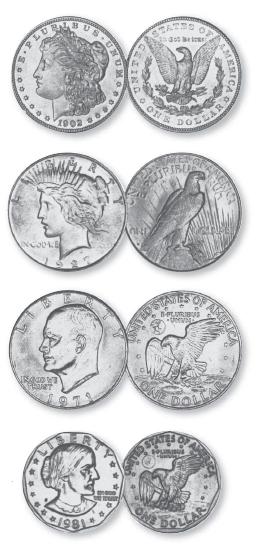
A basic type set of 20th century dollar coins would consist of (from top) a Morgan type, Peace type, Eisenhower type and Anthony type.
A person contemplating the collecting of Jefferson nickels by date and mintmark will find that three mints produced them: San Francisco, Denver and Philadelphia. Because the first two are branch mints serving smaller populations, their output has tended over time to be smaller than that of Philadelphia. This fact, repeated in other series, has helped give mintmarks quite an allure to collectors. It provides one of the major attractions in collecting coins by date and mintmark.
The key date for Jeffersons is the 1950-D when using mintages as a guide. In that year, production was just 2.6 million pieces. Because collectors of the time were aware of the coin’s low mintage, many examples were saved. As a result, prices are reasonable.
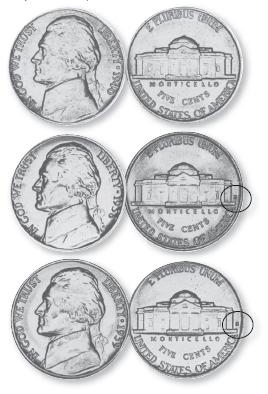
Jefferson nickels have been produced at the (from top) Philadephia, Denver and San Francisco Mints. Note the Denver and San Francisco mintmarks to the right of Monticello.
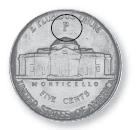
The wartime nickels of 1942-1945 marked the first time a “P” mintmark, for Philadelphia, was used.
The Depression-era 1939-D comes in as the most valuable regular-issue Jefferson nickel despite a mintage of 3.5 million – almost 1 million more than the 1950-D. The reason: Fewer were saved for later generations of coin collectors.
Date and mintmark collecting teaches hobbyists to use mintage figures as a guide but to take them with a grain of salt. Rarity, after all, is determined by the number of surviving coins, not the number initially created.
The Jefferson series is a good one to collect by date and mintmark, because the mintmarks have moved around, grown in size, and expanded in number.
When the series was first introduced, the Jefferson nickel was produced at the three mints previously mentioned. In 1942, because of a diversion of certain metals to wartime use, the coin’s alloy of 75 percent copper and 25 percent nickel was changed. The new alloy was 35 percent silver, 56 percent copper, and 9 percent manganese.
To denote the change, the mintmarks were moved and greatly enlarged. The pre-1942 mintmarks were small and located to the right of Monticello; the wartime mintmarks were enlarged and placed over the dome. What’s more, for the first time in American history, the Philadelphia Mint used a mintmark (“P”).
The war’s end restored the alloy and mintmarks to their previous status. The “P” disappeared. This lasted until the 1960s, when a national coin shortage saw all mintmarks removed for three years (1965-1967) and then returned, but in a different location. Mintmarks were placed on the obverse, to the right of Jefferson’s portrait near the date in 1968. In 1980 the “P” came back in a smaller form and is still used.
Another consideration arises with date and mintmark collecting: Should the hobbyist include proof coins in the set? This can be argued both ways. Suffice to say that anyone who has the desire to add proof coins to the set will have a larger one. It is not necessary nor is it discouraged.
Some of the first proof coins to carry mintmarks were Jefferson nickels. When proof coins were made in 1968 after lapsing from 1965 to 1967, production occurred at San Francisco instead of Philadelphia. The “S” mintmark was placed on the proof coins of that year, including the Jefferson nickel, to denote the change. Since that time, mintmarks used on proof examples of various denominations have included the “P,” “D,” “S,” and “W.”
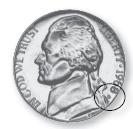
In 1968 the mintmarks reappeared on U.S. coins and production of proof coins resumed, this time at the San Francisco Mint. On the nickels, the mintmark moved from the reverse to the obverse below the date.
For all of the mintmark history that is embodied in the Jefferson series, prices are reasonable. For a first attempt at collecting coins by date and mintmark, it provides excellent background for going on to the more expensive and difficult types. After all, if you are ever going to get used to the proper handling of a coin, it is far better to experiment on a low-cost coin than a high-value rarity.
As one progresses in date and mintmark collecting and type collecting, it is important to remember that all of the coins should be of similar states of preservation. Sets look slapdash if one coin is VG and another is MS-65 and still another is VF. Take a look at the prices of all the coins in the series before you get too far, figure out what you can afford, and then stick to that grade or range of grades.
Sure, there is a time-honored practice of filling a spot with any old example until a better one comes along. That is how we got the term “filler.” But if you get a few placeholders, don’t stop there. By assembling a set of uniform quality, you end up with a more aesthetically pleasing collection.
The date and mintmark method used to be the overwhelmingly dominant form of collecting. It still has many adherents. Give it a try if you think it sounds right for you.
Before we leave the discussion of collecting U.S. coins, it should be pointed out that the two major methods of organizing a collection are simply guidelines. They are not hard-and-fast rules that must be followed without questions. Collecting should be satisfying to the hobbyist. It should never be just one more item in the daily grind. Take the elements of these collecting approaches that you like or invent your own.
It should also be pointed out that U.S. coinage history does not start with 1792, nor do all of the coins struck since that time conform precisely to the two major organizational approaches. But these two areas are good places to start.
There are coins and tokens from the American Colonial period (1607-1776) that are just as fascinating and collectible as regular U.S. Mint issues. There are federal issues struck before the Mint was actually established. See the Colonial price-guide section in this book.
There are special coins called commemoratives, which have been struck by the U.S. Mint since 1892 to celebrate some aspect of American history or a contemporary event. They are not intended for circulation. There was a long interruption between 1954 and 1982, but currently annual commemoratives are being offered for sale directly to collectors by the Mint.
Collecting commemoratives has always been considered something separate from collecting regular U.S. coinage. It is, however, organized the same way. Commemoratives can be collected by date and mintmark or by type.
Current commemoratives can be purchased from the U.S. Mint. Check the U.S. Mint Web site at www.usmint.gov. Hobbyists who order from the U.S. Mint’s Web site receive notices of product availability by e-mail. Hobbyists will get the various solicitations for not only commemoratives, but regular proof sets and mint sets and proof American Eagle bullion coins. Buying coins from the Mint can be considered a hobby pursuit in its own right. Some collectors let the Mint organize their holdings for them. They buy complete sets and put them away. They never buy anything from anywhere else.
Admittedly, this is a passive form of collecting, but there are individuals around the world who enjoy collecting at this level without ever really going any deeper. They like acquiring every new issue as it comes off the Mint’s presses.
Once done, there is a certain knowledge that one has all the examples of the current year. Obviously, too, collectors by date and mintmark of the current types would have to buy the new coins each year, but, of course, they do not stop there.
Varieties and errors make up another area. Under this heading come the coins the Mint did not intend to make. There are all kinds of errors. Many of them are inexpensive. Check out the U.S. Minting Varieties and Errors section in the price guide. If you want to pursue it further, there are specialty books that deal with the topic in more detail.
Canada
Starting point for the national coinage of Canada is popularly fixed at 1858. In that year a large cent was first produced for use in Upper and Lower Canada (Ontario and Quebec). These prices were intended to supplant local copper coinage, which in turn had been attempts to give various regions a medium of exchange.
What was circulating in Canada at the time was a hodgepodge of world issues. The large cent predates a unified national government by nine years, but it is considered the beginning of national issues nevertheless.
There are many similarities between the United States and Canada and their respective monetary systems. Both continent-sized nations thought in terms of taming the frontier, new settlements, and growth. Both came to use the dollar as the unit of account because of the pervasiveness of the Spanish milled dollar in trade. For each, the dollar divides into 100 cents.
However, Canada had a far longer colonial history. Many of its residents resisted the tide that carried the United States to independence and worked to preserve their loyalties to the British crown. As a result, Canada was firmly a part of the British Empire. So even today with its constitution (the British North America Act transferred from Westminster to Ottawa in 1982), parliamentary democracy, and a national consciousness perhaps best symbolized by the maple leaf, Canada retains a loyalty to the crown in the person of Queen Elizabeth II of the United Kingdom. Canada is a member of the British Commonwealth of Nations.
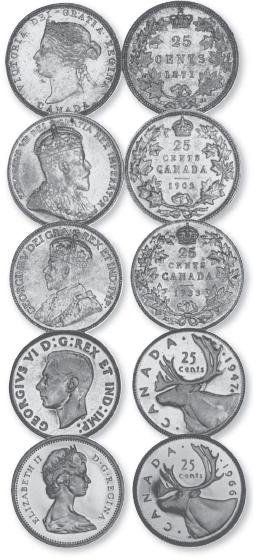
Canadian coins have depicted (from top) Queen Victoria, King Edward VII, King George V, King George VI and Queen Elizabeth II.
The effect of this on coins is obvious. Current issues carry the queen’s effigy. How Canada got its coins in the past was also influenced. The fledgling U.S. government set about creating its own mint as one of its earliest goals, despite that better-quality pieces could be purchased abroad at lower cost. Canada found that ties to mints located in England were logical and comfortable.
The Royal Canadian Mint was not established until 1908, when it was called the Ottawa branch of the British Royal Mint, and it was not given its present name until 1931. Both events are within living memory. Canadian coins, therefore, have a unique mixture of qualities. They are tantalizingly familiar to U.S. citizens yet distinctly different.
The coinage of a monarchy brings its own logic to the organization of a collection. Type collecting is delineated by the monarch. United Canada has had six. The first was Queen Victoria, whose image appeared on those large cents of 1858. Her reign began in 1837 and lasted until 1901.
She was followed by Edward VII, 1901-1910; George V, 1910-1936; Edward VIII, 1936; George VI, 1936-1952; and Queen Elizabeth II, 1952-present. All but Edward VIII had coins struck for circulation in Canada. The collectible monarchs, therefore, number five, but the longer reigns inspired changes of portraits over time to show the aging process at work. Legends also changed. When George VI ceased being emperor of India, Canada’s coins were modified to recognize the change.
Like U.S. coins, sizes and alloys were altered to meet new demands placed on the coinage. However, the separateness of each nation might best be summed up this way: Though the United States abolished its large cent in 1857, Canada’s was just getting under way in 1858. The United States put an end to the silver dollar in 1935, the very year Canada finally got its series going.
And Canada, the nickel-mining giant, used a small-sized silver five-cent coin until 1921, almost 50 years after the half dime was abolished in the United States. But whereas the Civil War was the major cause of the emergence of modern U.S. coinage as specified by the Coinage Act of 1873, World War I influenced the alterations that made Canada’s coins what they are today.
It might be assumed that change in the monarch also signaled a change in the reverse designs of the various denominations. A check of the Canadian price guide section shows this is not necessarily the case. Current designs paired with Queen Elizabeth II basically date back to the beginning of her father’s reign. The familiar maple-leaf cent, beaver five-cent piece, schooner 10-cent, caribou 25-cent, and coat-of-arms 50-cent have been running for more than 50 years. Significant changes were made to the 50-cent coin in 1959, but the reverse design remains the coat of arms.
So where does that leave type collectors? It puts them in a situation similar to categorizing the various eagles on U.S. coins. They can be universalists and accept the broadest definitions of type, or they can narrow the bands to whatever degree suits them best.
By checking the price-guide section, date and mintmark collectors will quickly note that their method of organization more or less turns into collecting by date. Though currently there are three mints in Canada – Hull, Quebec; Ottawa, Ontario; and Winnipeg, Manitoba – they don’t use mintmarks. Historically, few mintmarks were employed.
Ottawa used a “C” on gold sovereigns of 1908-1919 and on some exported colonial issues. The private Heaton Mint in Birmingham, England, used an “H” on coins it supplied to Canada from 1871 to 1907.
But the coins supplied to Canada by the British Royal Mint and later by its Ottawa branch did not carry any identifying mark. Collectors who confine their activities to the more recent issues need never think about a mintmark.
It would be easy to slant a presentation on Canadian issues to stress similarities or differences to U.S. issues. One should remember that the monetary structures of each evolved independently, but each was always having an impact on the other.
Common events, such as World War II, had a similar impact. For example, the Canadian five-cent coin changed in much the same way as the U.S. nickel. In Canada, nickel was removed and replaced first by a tombac (brass) alloy and then by chromium-plated steel. Peace brought with it a return to the prewar composition.
To see an example of differences between the United States and Canada, take the Canadian approach to the worldwide trend of removing silver from coinage. Canada made its move in 1968, three years after the United States. Instead of choosing a copper-nickel alloy as a substitute for silver, Canada looked to its own vast natural resources and employed pure nickel.
Canada also seems more comfortable with its coinage than the United States. Whereas the United States often feared confusion and counterfeiting from making the least little changes in its coins, Canada has long embraced coinage to communicate national events, celebrations and culture. Its silver-dollar series actually began as a celebration of George V’s 25 years on the throne.
Succeeding years saw additional commemorative $1 designs interspersed with the regular Voyageur design. When the centennial of national confederation was observed in 1967, all of the denominations were altered for one year. The United States only reluctantly tried out the idea on three of its denominations for the nation’s Bicentennial.
Ultimately, Canada began an annual commemorative dollar series in 1971. It issued coins for the 1976 Montreal Olympic Games and again in 1988 for the Calgary Olympic Games. Bullion coins were created to market its gold, silver and platinum output. A commemorative series of gold $100 coins was also undertaken. Canada, too, issues special proof, prooflike and specimen sets, similar to the United States.
Hobbyists who would like to be informed of new issues should write Royal Canadian Mint, P.O. Box 457, Station A, Ontario K1A 8V5, Canada. The mint also maintains special toll-free lines. In the United States, hobbyists may telephone the Royal Canadian Mint at 1-800-268-6468. In Canada, the number is 1-800-267-1871. You can get on the mailing list by using these numbers and you can buy currently available coins. (See Chapter 6 for Web information.)
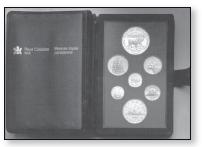
Like the U.S. Mint, the Royal Canadian Mint offers sets of coins in a variety of finishes to the collector market.
When collecting Canada, another thing to remember is the importance varieties play in the nation’s various series. Certainly, a type collector has no need to dwell on this information, but the date and mintmark collector may puzzle over the many extra identifying abbreviations in the price guide for certain coins. These varieties should not be confused with the U.S. variety-and-error category.
Here the varieties are not mistakes; they are deliberately created and issued variations of the standard design. We see Voyageur dollars on which the number of water lines changes. Other dollars count the number of beads.
These differences are minor. Though they were deliberately done to meet varying mint needs, they were not intended to be set apart in the public mind. The hobby, however, likes to look at things under a microscope.
Some varieties were indeed intended to be deliberately and noticeably different. An example of this occurs with 1947-dated issues. A maple leaf was placed on the 1947-dated cent through 50-cent issues. This indicated the coin was struck after George VI lost his title of emperor of India, as proclaimed in the Latin legend, but that the design had not yet been altered to reflect this. All of these varieties are considered integral parts of the Canadian series, and they are listed as such.
Do not construe any of this to mean there is no collecting of varieties and errors of the type common in the United States. There is. Collecting Royal Canadian Mint mistakes is just as active, just as interesting, and just as rewarding. After all, mint errors are universal. The methods of manufacture are the same. So the mistakes can be classified in the same manner.
Canada’s numismatic listings also include items from various provinces issued before they were part of the confederation. The largest portion of this section is devoted to Newfoundland, because it retained a separate status far longer than the other provinces – until 1949, in fact.
Advice given to collectors of U.S. coins also applies to collectors of Canadian coins: Do what interests you. Do what you can afford. Create sets of uniform grade.
The rules of rarity transcend national boundaries. The only thing to keep in mind is the relative size of the collecting population. Because Canada has only a tenth of the U.S. population, it stands to reason that the number of collectors in that nation is but a fraction of the U.S. number. A mintage that seems to indicate scarcity for U.S. coin, therefore, could indicate something quite common in Canada. Don’t forget that mintage is just a guide. The same factors that caused loss of available specimens or preserved unusually large quantities were at work in Canada, too.
Mexico
Coinage produced in Mexico dates to the establishment of a mint in Mexico City in 1536, more than 250 years before a federal mint was set up in the United States and more than 300 years before Canada circulated its own coins. The output of those extra centuries alone would make organizing a Mexican coin collection more challenging than a collection of U.S. or Canadian coins. But there are numerous other factors involved.
You say you like the kings and queens on Canada's coins? Mexico has kings, too – nearly 300 years’ worth, plus a couple of emperors. You say the ideals of liberty embodied by the great men and women on U.S. coins is more your cup of tea? Mexico’s coins also feature men and women committed to liberty.
In addition, Mexico is the crossroads of civilizations and empires. The great pyramid-building society of southern Mexico and Central America met its end at the hands of the Spanish conquistadors led initially by Hernando Cortez. The great Aztec empire was looted and overturned in 1519-1521 in the name of Spain.
The great natural resources of the area then supported successive Spanish kings in their grand dreams of dominating Europe. Through the doors of the Mexico City Mint and later facilities scattered about the country passed legendary quantities of silver. Even today the country ranks at the top of the list of silver producers.
But while Spain could dominate Mexico for a long time, the basic ideals of liberty and human dignity eventually motivated the people to throw off the foreign yoke. Unfortunately, victory was often neither complete nor wisely led. And in more recent years, the scourge of inflation had exacted a high toll on the currency itself. The numismatic consequences of a long history punctuated by periods of turmoil are an abundance of denominations, metals and types.
It is tempting for a would-be collector of Mexican coins to forget about anything that happened in the country prior to its monetary reform of 1905. By starting at that point, a hobbyist can happily overlook anything other than a decimal monetary system in which 100 centavos equal 1 peso. That system is as modern as any. The coins’ striking quality is high. Legends are easy to read and understand, and the variety of issues is wide but not overwhelming.
There always is a certain logic to begin the collecting of any country with recent issues. The costs of learning are minimized, and as one becomes comfortable, a level of confidence can be built up sufficient to prompt diving further into the past.
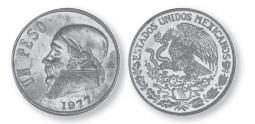
One thousand of these equaled one new peso as 1993 began.
The issues of 1905 to date also more easily fit into the mold of type collecting and collecting by date and mintmark. To take type collecting, for example, let’s look at the peso. In 1905 it was a silver-dollar-sized coin with a silver-dollar-sized quantity of bullion in it, 0.786 ounces. In 1918 it was reduced to 0.4663 ounces; in 1920, 0.3856 ounces; in 1947, 0.2250 ounces; 1950, 0.1285 ounces; 1957, 0.0514 ounces; and in 1970 silver was eliminated completely in favor of a copper-nickel alloy.
At almost every one of those steps, the design changed, too. After sinking to 3,300 to the U.S. dollar, monetary reform dropped three zeroes in 1993. The new peso, equal to 1,000 old ones, is now about 14 to the U.S. dollar.
By beginning with 1905, a date and mintmark collector misses out on issues of the various branch mints that were located around the country. Regular issues were all struck in Mexico City. Yearly output was reasonably regular for the various denominations, so date sets are extensive.
There have been rumblings since the early 1980s that Mexico would abandon the peso because of its greatly reduced value. The government, however, has been working hard to retain it since the monetary reform. So far it has succeeded.
One thing the government cannot do, however, is turn the clock back to a time when the fractional denominations of 1, 2, 5, 10, 20, 25, and 50 centavos were relatively high face values. However, it is stimulating to assemble sets because they offer a range of rarities. They are neither so expensive that it would prevent a collector from acquiring them at some point, but neither are they so common that you can walk into a shop, write a check, and come away with all of the 20th century sets complete. Check out the price guide section and see.
Gold in the post-1905 era is basically so much bullion. There are some scarcer pieces and some strikingly beautiful designs, such as the Centenario, a gold 50-peso coin containing 1.2 ounces of bullion. It was first struck in 1921 to mark 100 years of independence. Because Mexico actively restruck its gold coins, however, it is virtually impossible to tell an original issue from the newer version.
The result is a retail price structure based on metallic content. Gold, however, does not conjure up the images that silver does. Silver is the magic word for Mexico. That, of course, means the peso.
The modern Mexico City Mint also strikes commemoratives and collector sets from time to time. These are generally marketed to collectors through private firms, details of which are published in hobby newspapers like World Coin News. Mexico, like the United States and Canada, also issues gold and silver bullion coins.
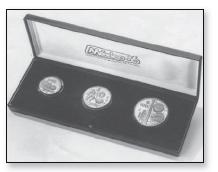
Mexico also strikes commemorative coins for the collector market. They are available through private firms in the United States.
These also are marketed through arrangements with private firms. Interestingly, Mexico’s many gold-coin restrikes were the bullion coins of their day. They had the advantage of ready identification, and they were legally tradable according to gold-coin regulations that existed in the United States from 1933 through 1974.
It is appropriate that we conclude discussion of the modern period on the concept of bullion, because bullion is at the root of Mexico’s numismatic history. That is a period to which we now turn.
When Cortez toppled the Aztec Empire, for a time the wealth returning to Spain was merely that taken by the victors from the vanquished. But the business of permanently administering a vast area in the name of the Spanish king, exploiting its natural resources, and funneling the proceeds to Spain quite soon involved the establishment of a mint in Mexico City. This was undertaken in 1536, just 15 years after the end of Aztec dominion.
At first, the authorized coins were low denominations: silver quarter, half, 1, 2, 3, and 4 reales, and copper 2 and 4 maravedis. To understand their face values and how they related to each other, let’s take the common reference point of a silver dollar. The silver dollar is 8 reales, and you might recognize the nickname for the denomination of “piece of eight” from pirate lore. The eighth part, the silver real, was divided into 34 copper maravedis. That means the 8 reales was worth 272 copper maravedis.
The copper coinage was hated and soon abolished, not to reappear until 1814. The silver coins were fine as far as they went. When the mines of Mexico began producing undreamed of quantities of metal, however, it was the 8 reales that took center stage. This occurred after 1572. The piece of eight became the standard form for shipping silver back to Spain.
Mexico City’s output was prodigious. Minting standards were crude. All denominations produced are called “cobs,” because they are basically little more than irregular-looking lumps of metal on which bits and pieces of design can be seen. The only constant was weight, fineness, and the appearance of assayer’s initials (which guaranteed the weight and fineness). Not showing those initials was cause for severe punishment.
Designs showed the arms of the monarch on one side, a cross on the other, appropriate legends, and an indication of denomination. The period of cob issues lasted until 1732. Rulers of the period start with Charles and Johanna, 1516-1556; Philip II, 1556-1598; Philip III, 1598-1621; Philip IV, 1621-1665; Charles II, 1665-1700; Philip V, 1700-1724 and 1724-1746; and Luis I, 1724.
Modern mint machinery began turning out coins in 1732. Quality was similar to today. The arms design was continued. It was not until 1772 that the monarch’s portrait began appearing. The honor of this numismatic debut belongs to Charles III. Kings of this period are Ferdinand VI, 1746-1759; Charles III, 1760-1788; Charles IV, 1788-1808; and Ferdinand VII, 1808-1821. The Standard Catalog of Mexican Coins by Colin R. Bruce II and Dr. George W. Vogt is recommended to those who want to study this period in greater depth.
The revolutionary period begins in 1810, when a parish priest, Miguel Hidalgo y Costilla, issued the call for independence. The first attempts to achieve this were violently suppressed. Hidalgo was executed, but independence did come in 1821.
With revolt against central authority came a dispersal of the right to strike coins. Mexico City continued as the major facility, but other operations began. The list of these over the next century is lengthy. Mintmarks and assayer initials proliferated.
The old colonial coinage standard survived the period. The 8 reales and its parts carried on. A slight reduction in bullion content had been ordered by the king in 1760, but otherwise things continued as they were. Gold was coined during the colonial period beginning in 1679 based on an 8-escudo piece, which divided into eighths just like the 8 reales. Gold, however, was not as important as silver.
Mexico’s first emperor came shortly after independence. He was a leader in the struggle that set Mexico free from Spain. Augustin de Iturbide, originally an officer in the service of Spain, was proclaimed emperor in 1822. He abdicated in 1823 and was executed in 1824.
The second emperor had a reign almost as short as the first. Maximilian I, emperor only because he had a French army to secure the throne, reigned from 1863 to 1867. He was shot by a firing squad when the French left.
He is remembered numismatically because he decided to decimalize the coinage. The centavo and peso were born. Soon afterward, the republic was reestablished. Further monetary changes were minor thereafter until 1905.
Collectors focusing on Mexico can devote much time to the study of the quasi-official issues of rebels during the periods of instability. They can look at hacienda tokens, which were issued by large farms or ranches that employed hundreds or thousands of people. Or they can pick whichever period in Mexico’s history that fascinates them most. Whatever collectors of Mexico eventually settle on, they will find it rewarding.
Where to write for more information:
World Coin News: 700 E. State St., Iola, WI 54990.